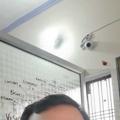Question Text
Question 1 :
State whether true or false :Electric flux through a closed surface is equal to total flux due to all the charges enclosed within that surface only.
Question 3 :
A glass rod rubbed with silk is brought near the fur rubbed with an ebonite rod. What will be your observation between them? <br>
Question 4 :
A charged body is brought near an uncharged gold leaf electroscope. What will be your observation if the body is charged?
Question 5 :
If a charge on the body is 1 nC, then how many electrons are present on the body?
Question 6 :
The inward and outward electric flux from a closed surface are respectively $$ 8\times 10^{3}$$ and $$ 4\times 10^{3}$$ units.Then the net charge inside the closed surface is
Question 7 :
The electric field in a certain region is acting radially outward and is given by $$E=Ar$$. A charge contained in a sphere of radius '$$a$$' centered at the origin of the field, will be given by :<br/>
Question 8 :
The point charges $$q_1 = 2 \mu C$$ and $$q_2 = 1 \mu C$$ are placed at distances b= 1 cm and a = 2 cm from the origin on the y and x axes as shown in Fig. 11.50. The electric field vector at point P (a, b) will subtend an angle $$\theta$$ with the x-axis given by
Question 9 :
A charge $$Q$$ is placed at the centre of an uncharged, hollow metallic sphere of radius $$a$$. Find the surface charge density on the inner surface and on the outer surface.
Question 10 :
Consider an area element $$dS$$ at a distance $$r$$from a point P. Let $$\hat r$$be the unit vector along the outward normal to $$dS$$.If $$\alpha$$ is the angle between $$\hat r$$ and $$dS$$,the element of the solid angle subtended by the area element at P is defined as
Question 11 :
An atom is modelled as a point charge of +e at the nucleus with the electron charge distribution, described by the charge density<br/><br/>$$\rho=\dfrac{-15 e}{8 \pi a^3}\left ( 1-\dfrac{r^2}{a^2} \right )$$  for  $$r  \leq  a  <  0$$<br/>$$\rho \simeq 0  $$ for $$ r>a, $$ where 'a' is a constant.<br/>The net charge contained within a sphere of radius r < a is :



























